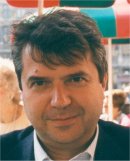|
|
|
Boundary Layer Separation
Control in Turbomachinery Components: A Short Review and Examples

Professor Pietro Zunino
Head of Department
Dipartimento di Macchine, Sistemi Energetici e Trasporti
Universita di Genova
Via Montallegro 1, I-16145 Genova
E-mail: pietro.zunino@unige.it
Abstract: In the last thirty years many efforts have been done to
apply flow control devices inside a real environment in a reliable and
efficient way. Even though the concept of boundary layer control was
introduced by Prandtl at the beginning of the 20th century only recently it
has been thought to control the flow inside complex machine such as
aeroengine. In particular inside a modern turbomachine the most interesting
application of a boundary layer control device is the prevention of flow
separation. Boundary layer separation is in fact one of the main causes of
total pressure losses, moreover the suppression or delay of separation may
allow the introduction of more aerodynamically loaded airfoil and surface.
In a modern aero engine this possibility may lead to improvements of the
performances of compressors, turbines and diffusing ducts. For this reason,
the experimentation of boundary layer separation control methods applied to
internal aeroengine flow becomes of primary importance.
Two examples of separating boundary layers are considered:
- laminar boundary layers on a high lift turbine profile;
- turbulent boundary layer on turbine internal ducts.
The strategies for the two cases are different. Laminar separation may be
cured simply by enforcing the boundary layer transition by means of a
passive device enhancing turbulence production or by means of a synthetic
jet.
On the contrary turbulent boundary layer separation control requires a large
scale momentum transfer to the wall. That can be accomplished by low profile
vortex generators.
Brief Biography of the Speaker:
Laurea in Mechanical Engineering, University of Genova with honours.
Von Karman Institute Diploma Course in Turbomachinery with honours.
Designer of Turbomachinery at Hydroart S.p.A. (Ansaldo, Riva, Tosi), Milano.
Professor of Fluid Machines at the Faculty of Engineering, University of
Genova.
Head of the Fluid Machines, Energy Systems and Transportation Department,
University of Genova.
Prof. Pietro Zunino is author of more than 100 scientific papers on flow in
turbomachines concerning the following research subjects:
- potential flow and boundary layers in turbomachines;
- development of experimental techniques for flow measurements in
turbomachines (HW, LDA);
- experimental analysis of turbulence and secondary flows in turbine
cascades ;
- experimental analysis of relative flow and turbulence in axial and
centrifugal rotors;
- rotor-stator aerodynamic interaction in turbomachines;
- time varying wake flow characteristics and profile boundary layers in
turbine cascades;
- unsteady aerodynamics of gas turbine premixing burners;
- boundary layer separation control.
He has been research manager for several research contracts with industries.
He has contributed to several European Research Projects related to the
unsteady aerodynamics of aero-engine components.
Prof. Pietro Zunino has been session chairman in International Scientific
Conferences.
He has been scientific reviewer for International Conferences and Scientific
Journals.
He has been independent evaluator for the European Commission VI and VII
Framework, Aeronautical and Space.
|
|
|